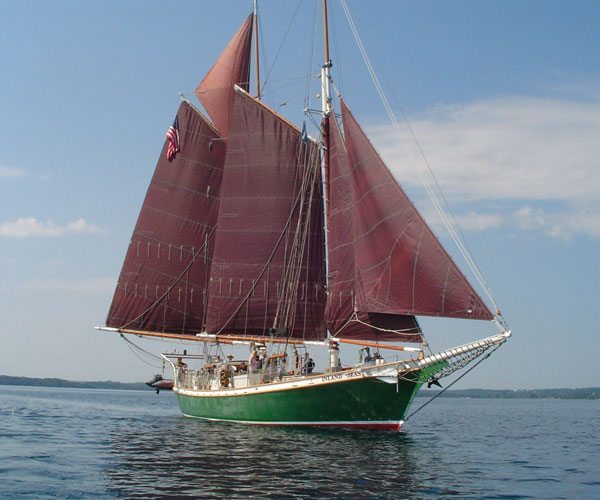
The science ship and floating classroom. Image: Inland Seas.
A group that teaches people about the Great Lakes from aboard a schooner is vying for $25,000 to provide scholarships and scientific equipment to further its work.
The deciding factor? Facebook votes.
Based out of Suttons Bay, Mich., the Inland Seas Education Association develops stewards and next generation scientists of the Great Lakes by setting sail with students on a traditionally rigged schooner to engage the community’s interest in the Great Lakes.
To further that mission, it is going after a grant program started in 2012 by the State Farm insurance company. The State Farm Neighborhood Assist is an annual competition that gives away $1 million in $25,000 increments.
“The grant funds would be put into our scholarship fund so that schools who cannot pay for a trip would have a portion of their Schoolship trip paid for,” said Sally Somsel, a longtime Inland Seas Education association volunteer who wrote the proposal.
The money would also help replace broken thermometers, damaged plankton nets, testing chemicals and for other technology upgrades.
“If we want to inspire next generation Great Lakes scientists, they need to see the next generation of scientific instruments and tools,” said Fred Sitkins, Inland Seas executive director. “We want to make sure that’s where we’re investing our money this year, as equipping ourselves to be ready for those next 25 years, to demonstrate to students what they’re going to experience when they enter the science field.”
On Friday the Facebook voting round closes. The top 40 organizations with the most votes will receive a $25,000 grant. To vote for the Inland Seas Education Association, follow the link here. Each person is allowed to vote up to ten times a day. The group has yet to break into the top 40.
Organizations from across the United States and Canada submit applications to compete for the money. During the first round of the competition, the top 200 are picked by the State Farm Youth Advisory Board.
“What’s really great about these applications is it’s so diverse, and we really don’t see any particular causes or any specific niche causes,” said Suneil Kamath, a member of the Youth Advisory Board.
A sophomore at Case Western Reserve University in Ohio, Kamath is participating in his second year on the board. He is one of 30 students between the ages of 17 and 20 that choose the top 200 applicants to move on to the Facebook voting round.
“There are three main questions that are asked on the application,” he said. “So the first one is how much does the organization’s cause focus on that need? The second one is how you feel the $25,000 would address that need? And then the third one is how much of a lasting impact this proposal will have on the community?”
The applicants in competition for the grant have a wide variety of causes. However, they all fall into one of three main categories: community development, education and safety.
At the competition’s close, the 40 organizations with the most votes will each receive a $25,000 grant.
Celebrating its 25th anniversary, the grant would help Inland Seas look toward the next 25 years.

Education Coordinator and Lead Scientist Emily Shaw holds a fish while it is measured. Image: Inland Seas.
“We’ve now taught 100,000 students on board which is an incredible milestone,” Sitkins said. “And we’ve been doing it a long time and we’ve built up an incredible support base.”
And it’s that support base of employees and volunteers Inland Seas wants to honor this year.
“They’ve helped to create an incredible organization that’s made a huge difference already,” said Sitkins. “And then hoping to instill the fact that we’re looking forward to the next 25 years and surpassing the 200,000 student mark is kind of our next goal.”
But the hopes of Inland Seas go beyond just boosting numbers.
“If we’re able to inspire kids to be scientists, hopefully they will also be so inspired with the Great Lakes that they’ll be scientists with the mission of protecting the Great Lakes themselves. So we would hopefully be caring that mission on for generations to come,” said Sitkins.
